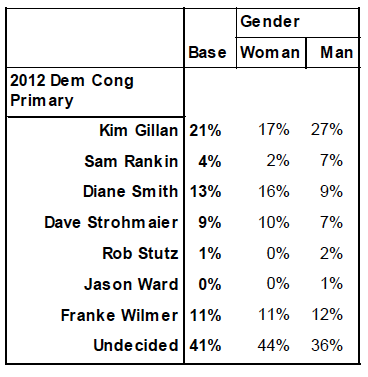

That’s what the latest PPP survey of Montana U.S. Senate and House races reports. But is that differential believable? Why would any woman running in a Democratic primary do so much better among men than women?
Here’s PPP’s cross tabulation on gender:

Here are the same data presented as a horizontal bar graph. Positive numbers indicate more support from men than from women. Negative numbers indicate more support from women.
And here’s a scatter plot showing how much of an outlier Gillan’s reported support among men seems to be:
I emailed PPP asking for clarification, but I’m not altogether certain I’ll even get a reply, let alone a prompt reply. Meanwhile, these seem to be the possibilities:
I lean toward the third possibility, but that’s a hunch based on knowing that more women than men are Democrats. It’s not a conclusion for which I have convincing evidence.
Still, one wonders. Diane Smith does much better among women than men, owing I suspect to admiration for her success in business. Franke Wilmer, who’s overtly courting an identity vote by women, actually does a point better among men, but that’s virtually a tie and one shouldn’t make too much of the difference.
Given the poll’s small sample, there’s a fair amount of uncertainty in the numbers reported. That’s not an argument for dismissing the numbers as worthless, but it is an argument for exercising caution when drawing conclusions.